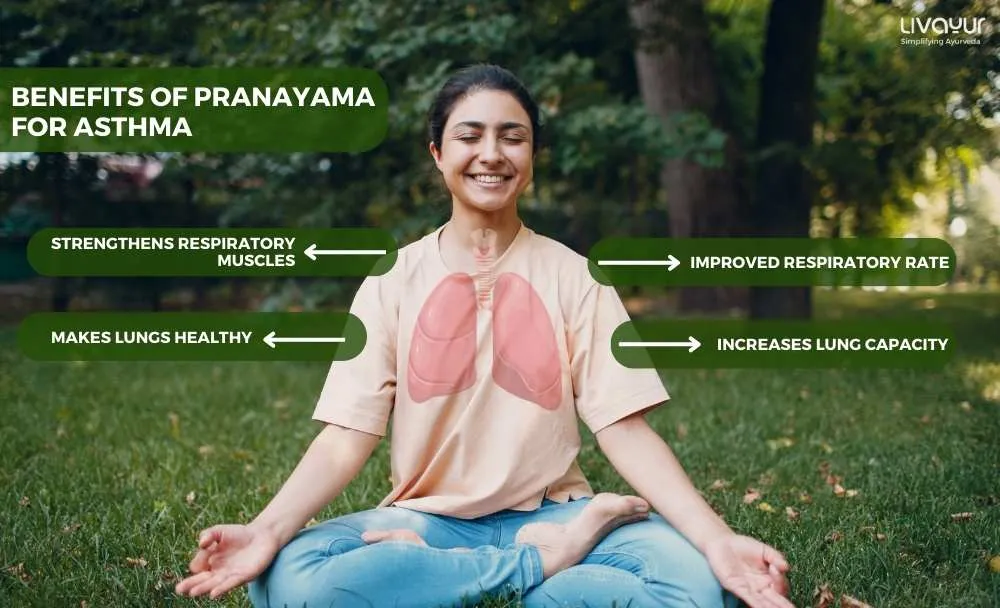
More often than not people take breathing for granted unless they are among those few who suffer from breathing illness and complications such as asthma. Asthma is a respiratory disease that severely narrows the airways in the lungs making it nearly impossible to catch a breath. The condition requires people with asthma to always be cautious and vigilant as even a small trigger can lead to a serious attack that can be difficult to handle. However, Ayurveda and Yogic lifestyle recommendations suggest that asthma can be well-managed with breathing exercises such as Pranayama. How can that help? We’ll see here.
Asthma: The Ayurvedic Perspective
Asthma in Ayurveda is referred to as Svasa Roga which can translate to breathing/respiratory disease. According to the ancient Ayurvedic text, Charak Samhita, Asthma is caused due to the imbalance of the three Doshas – Vata, Pitta and Kapha. The condition can cause symptoms such as difficulty breathing, wheezing, coughing, and irritability. Ayurveda differentiates asthma based on the type of Dosha imbalance. It identifies five major types namely – Maha Svasa, Urdhva Svasa, Chinna Svasa, Tamaka Svasa, and Ksudra Svasa.
Is Pranayama Good for Asthma?
Although asthma is an incurable disease, modern medicine has several methods to help patients manage it better. However, it often requires the consumption of medicines and carrying an asthma pump around all the time. For such reasons, many patients are moving to alternative therapies like Ayurveda. Pranayama, a Yogic breathing exercise, has gained popularity in the past few years as it’s believed to benefit asthma patients.
Today, Pranayama for asthma has been proven beneficial by research studies and has enough scientific evidence to back the claims. Several studies have found that regular Pranayama practice can have positive effects on asthma patients and benefit them in the below-mentioned ways:
1. Improved Respiratory Rate
Studies have found that Yoga practice brings a significant reduction in basal oxygen demand which is beneficial for asthma patients. It is also found that Pranayama leads to relaxation in the skeletal muscle which creates voluntary control over respiratory muscles.
2. Increases Lung Capacity
It has been proven that Pranayama and other breathing techniques increase lung capacity. When lung capacity is increased, breathing becomes comfortable, and respiratory muscle strengths also increase.
3. Strengthens Respiratory Muscles
Certain forms of Pranayama can be beneficial for increasing respiratory muscle strength as Pranayama helps ensure that your body uses lung spaces with the help of respiratory muscles. This increases the peak expiratory flow rate which is considered to be essential for opening small airways in the lungs.
4. Makes Lungs Healthy
Pranayama helps the lungs and chest inflate and deflate to their fullest capacity which in turn not only strengthens the respiratory muscles but also improves the health of the lungs.
Pranayamas to treat asthma
Here are some types of Pranayama commonly recommended for treating asthma.
1. Diaphragmatic Breathing (Pursed Lip Breathing)
It involves inhaling deeply and allowing the diaphragm to expand fully. The next step is exhaling slowly through pursed lips. Diaphragmatic breathing helps improve lung capacity and promotes a relaxed breathing pattern.
2. Alternate Nostril Breathing (Nadi Shodhana)
It involves inhaling and exhaling through each nostril at a time, alternating between the left and right sides. The practice can balance the body’s energy flow and enhance respiratory function.
3. Bhramari Pranayama (Bee Breath)
Bhramari involves inhaling profoundly and exhaling while making a humming sound resembling the buzz of a bee. It calms the nervous system and improves respiratory control.
4. Kapalbhati Pranayama (Skull-Shining Breath)
Kapalbhati involves forceful exhalations through the nostrils while keeping inhalations passive. It helps clear the respiratory passages and increase lung capacity.
5. Ujjayi Pranayama (Victorious Breath)
Ujjayi involves slightly constricting the back of the throat during inhalation and exhalation. It enhances lung capacity and increases oxygen intake.
6. Dirga Pranayama (Three-Part Breath)
Dirga Pranayama focuses on breathing deeply into the three parts of the lungs—abdomen, ribcage, and chest. It increases oxygenation and supports better control over breath.
Precautions to remember when doing Pranayama to treat asthma
Here are some precautions to remember when incorporating Pranayama to treat asthma.
1. Individualized approach
Pranayama practices vary, and not all techniques may suit everyone. Take the guidance of a qualified yoga teacher who can tailor Pranayama sequences to your needs.
2. Gradual progression
Begin Pranayama practices gradually, especially if you are new to breathing exercises. Avoid overexertion, and listen to your body’s signals. Gradual progression allows your respiratory system to adapt without triggering asthma symptoms.
3. Avoid over breathing
Pranayama aims to enhance breathing and avoid excessive or forceful inhalations and exhalations. Overbreathing may lead to hyperventilation and potentially trigger asthma symptoms.
4. No breath retention (kumbhaka)
Individuals with asthma should generally avoid breath retention (kumbhaka) during Pranayama. Holding the breath for prolonged periods may lead to oxygen imbalance and could trigger an asthma attack.
5. Avoid allergic environments
Practice Pranayama in a clean and well-ventilated space. Avoid environments with potential allergens or pollutants that may worsen asthma symptoms.
Conclusion
Including pranayama in a holistic asthma management plan can enhance respiratory well-being. The rhythmic and controlled breathing techniques offered by pranayama help strengthen the respiratory muscles, promote relaxation, and reduce stress. However, individuals with asthma must consult their healthcare providers before starting any new practices. It will ensure pranayama is a safe and suitable addition to their personalized treatment regimen.
FAQs
1. How to do Pranayama for asthma?
Start with gentle pranayama techniques like Diaphragmatic Breathing and gradually progress to Nadi Shodhana (Alternate Nostril Breathing) and Ujjayi Pranayama. Ensure a relaxed environment, sit comfortably, and practice thoroughly.
2. What is the best Pranayama for asthma?
The best Pranayama for asthma varies among individuals. However, Nadi Shodhana (Alternate Nostril Breathing) and Ujjayi Pranayama are often recommended for their potential to enhance respiratory function and promote lung health.
3. What is the significance of Pranayama in asthma?
Pranayama in asthma is a complementary practice that focuses on controlled breathing. It may improve lung capacity, strengthen respiratory muscles, and alleviate stress.
4. Essential Tips for Pranayama for Asthma Patients
a. Start with gentle techniques.
b. Practice in a clean, well-ventilated space.
c. Avoid breath retention (kumbhaka).
d. Progress gradually and listen to your body.
e. Consult healthcare providers before starting.
5. What is Pranayama in Ayurveda?
In Ayurveda, Pranayama is a vital practice that involves controlled and mindful breathing to balance the essential life force, or “prana.” It is a balanced approach to improving physical, mental, and spiritual well-being.
6. Can Pranayama cure asthma?
While Pranayama is not a cure for asthma, it can be a beneficial complementary therapy. Regular practice may improve respiratory function, reduce stress, and improve asthma management. However, it should not replace prescribed medical treatments. Individuals should consult healthcare providers for comprehensive asthma care.
Disclaimer: The information provided here is for general information and is not meant to substitute any medical advice. Please consult your doctor for appropriate medical consultation.
















